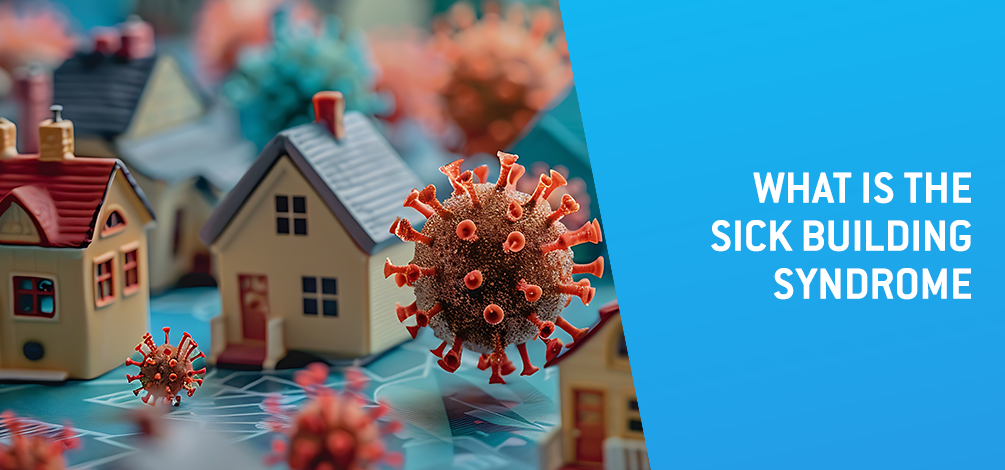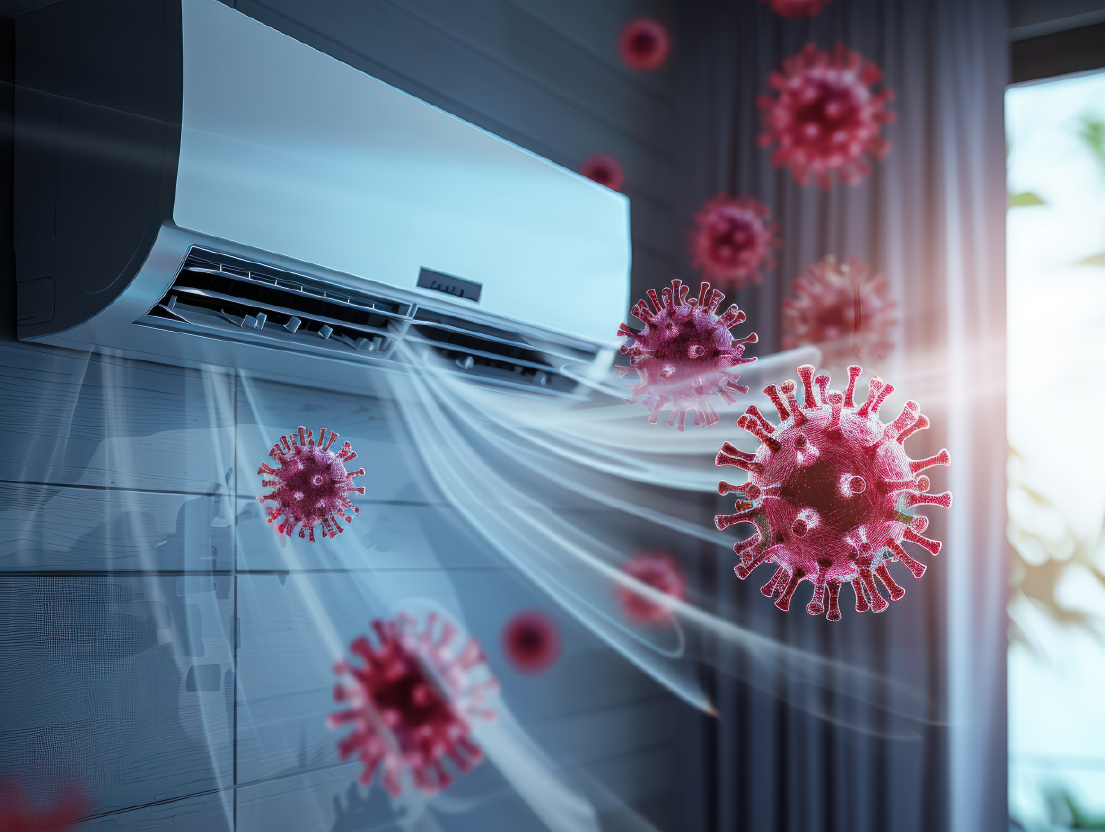What is the Sick Building Syndrome

Sick Building Syndrome (SBS) is a growing health concern, particularly as we continue to spend more time indoors.
Sick Building Syndrome (SBS) is a growing concern in modern occupational and environmental health, particularly as we continue to spend more time indoors. This condition describes a set of non-specific health complaints experienced by individuals in certain buildings, especially office environments.
Although the symptoms usually subside when people leave the building, the impact on health, well-being, and productivity can be significant. The emergence of SBS as a major issue began in the 1970s, largely due to the construction of airtight, energy-efficient buildings during the energy crisis, which, while conserving energy, also trapped pollutants indoors.
We will be exploring the causes, symptoms, risk factors, and preventive measures related to SBS in this article.
By understanding this matter, we can implement better strategies to create healthier indoor environments and improve occupational health.
Symptoms of Sick Building Syndrome
The symptoms are diverse and can vary significantly among individuals. The most commonly reported symptoms include:
- Mucous membrane irritation: Eye, nose, and throat irritation
- Neurotoxic effects: Headaches, fatigue, difficulty concentrating, and irritability
- Respiratory issues: Coughing, chest tightness, and wheezing
- Skin complaints: Dry, itchy skin or rashes
- Gastrointestinal problems: Nausea
- Other complaints: Dizziness, muscle aches, and fever
A key characteristic of SBS is that these symptoms worsen the longer an individual remains in the building and improve after leaving.
It is also common for multiple occupants of the same building to report similar health issues, making it easier to identify a possible link between the environment and the symptoms.
Causes and Contributing Factors
SBS is a multifactorial condition, with several potential causes contributing to its development:
- Inadequate ventilation: Poor air circulation and insufficient fresh air intake are often the reasons behind the issue. Buildings constructed to conserve energy tend to have reduced ventilation, which can trap indoor pollutants.
- Chemical contaminants: Volatile organic compounds from building materials, furnishings, cleaning products, and office equipment can accumulate in poorly ventilated areas. Common contaminants include benzene, styrene, and other solvents, which may off-gas from materials such as carpets, furniture, and adhesives.
- Biological contaminants: Molds, bacteria, viruses, dust mites, and other biological agents can thrive in damp or inadequately maintained buildings, contributing to SBS symptoms. Contaminated HVAC systems or poorly located air intakes can also introduce outdoor pollutants, further exacerbating indoor air quality problems.
- Physical factors: Poor lighting, excessive noise, inadequate temperature control, and low humidity levels can lead to discomfort, stress, and exacerbate SBS symptoms.
- Psychological factors: Workplace stress and poor interpersonal relationships can also play a role in amplifying the symptoms associated with SBS.
Investigating Sick Building Syndrome
Diagnosing Sick Building Syndrome (SBS) can be difficult due to its non-specific symptoms. A systematic investigation is essential to uncover the root causes of these symptoms.
The first step involves interviewing the affected occupants. Understanding when, how long, and how severe their symptoms are can reveal potential environmental triggers related to the building.
By combining interviews, building inspections, environmental data, and medical evaluations, the investigation can narrow down the causes of SBS and guide corrective actions.
Next, a detailed inspection of the building is crucial. Examining the ventilation systems and checking for potential contamination sources, like malfunctioning HVAC units or moisture, helps identify maintenance issues that may contribute to SBS. A "walk-through" can quickly reveal these problems.
Environmental monitoring is also necessary. Air quality parameters such as temperature, humidity, CO2 levels, and pollutants must be measured to assess indoor air quality, as these factors play a significant role in SBS.
While no specific medical test can diagnose SBS, ruling out other health conditions is important. Medical evaluations help determine if the building environment is indeed causing the symptoms.

Prevention and Management of Sick Building Syndrome
Addressing SBS requires a multi-pronged approach, involving both environmental improvements and workplace management strategies:
- Improving ventilation: Ensuring that HVAC systems are properly designed, maintained, and capable of providing adequate fresh air is critical. If pollutants are present in specific areas, such as restrooms or copy rooms, direct ventilation may be necessary to prevent their spread.
- Source control: Identifying and removing sources of indoor air pollutants is an essential part of managing SBS. Routine HVAC maintenance, waterproofing to prevent mold growth, and careful selection of low-emission building materials can help. Additionally, proper storage and use of chemicals such as paints, solvents, and adhesives should be prioritized, particularly in well-ventilated areas.
- Air cleaning: Installing high-efficiency air filters and incorporating design elements that promote natural light and air circulation (such as skylights, terrace gardens, and indoor plants) can significantly reduce the concentration of indoor pollutants.
- Building design: When constructing or renovating buildings, choosing natural, non-toxic materials and incorporating design features that promote good indoor air quality are key. Using solar heating and minimizing electromagnetic radiation can also help create a healthier environment.
- Psychosocial factors: Stress management and improving workplace conditions, such as reducing noise and overcrowding, can play a role in alleviating SBS symptoms.
Legislation and Guidelines
Some regulatory bodies have developed guidelines to address SBS and ensure healthier indoor environments. For example, the American Society of Heating, Refrigerating and Air-Conditioning Engineers (ASHRAE) recommends that buildings achieve a minimum of 8.4 air exchanges per 24 hours to maintain adequate ventilation.
In addition, smoking bans and restrictions in the workplace help reduce the concentration of harmful pollutants in indoor spaces.
In Europe, workers are often involved in discussions about changes in their workplace environment, and laws are being implemented to create safer, healthier office spaces. As awareness of SBS grows, more legislative measures may follow to enforce better indoor air quality standards.
A complex but solvable challenge
Sick Building Syndrome represents a complex challenge in modern indoor environments. To address it effectively, building managers, employers, and regulatory bodies must take a proactive approach, ensuring that ventilation systems are adequate, pollutants are minimized.
By fostering healthier indoor spaces, we can improve both the physical and mental well-being of workers, ultimately leading to more productive and sustainable workplaces.
The Role of Tekon Electronics Solutions
Tekon Electronics offers innovative solutions that can play a crucial role in managing and preventing Sick Building Syndrome.
Our wireless sensors and transmitters are designed to monitor key ambient variables. By leveraging its cutting-edge technology, it’s possible to gain real-time insights about indoor environment and take proactive measures to maintain air quality and occupant comfort.
One of Tekon’s standout products is the DUOS inHYGROTEMP, which monitors both temperature and humidity. These are two critical factors in SBS, as inadequate control over these variables can lead to the growth of biological contaminants like mold.
Another key product, the DUOS inCO2, measures temperature and carbon dioxide concentration. High CO2 levels are often an indicator of poor ventilation, which is a major contributor to SBS.
Both products integrate seamlessly with the Tekon IoT Platform, enabling users to visualize data in real-time, set alerts, and analyze trends over time. This kind of data-driven approach allows building managers to quickly address any issues, ensuring a healthy indoor environment.
With Tekon Electronics’ solutions, there is a way to take a proactive, technology-driven approach to improving air quality, helping to reduce the incidence of SBS and enhancing the overall well-being of building occupants.
Sumedha M Joshi. The sick building syndrome. https://pmc.ncbi.nlm.nih.gov/articles/PMC2796751/
NHS. Sick building syndrome. https://www.nhs.uk/conditions/sick-building-syndrome/
WebMD. Sick-Building Syndrome. https://www.webmd.com/men/features/sick-building-syndrome
Tjandra Yoga Aditama, Sita Laksmi Andarini. Sick building syndrome. https://imsear.searo.who.int/items/223ef836-fbdd-4ddb-ac99-1ff955047f88